F1 tires don’t seem to last long compared to your average road car tires. But they need to withstand massive forces, as Formula 1 cars can sometimes corner at speeds of up to 190 miles per hour. The tires need to be strong enough to endure multiple laps, but just how long F1 tires last can vary widely.
F1 tires can last anywhere from a few laps up to 50+ laps. Formula 1 tires are designed for performance rather than longevity. This means that the most durable tires won’t last more than 40 laps (about 120 miles) in most cases, depending on the track conditions and the compound of tires being used.
While I’m more known for my Formula 1 racetrack prints, I’ve written hundreds of articles on F1. Many factors influence how long F1 tires last. Below, I’ll explain why F1 tires have a shorter lifespan and discuss how many laps each tire compound can typically endure. Keep reading for more details.
How Many Laps Do F1 Tires Last?
F1 tires last varying numbers of laps, with soft tires sometimes only lasting a handful, and hard tires sometimes lasting 40+ laps. However, we may also see soft tires last 20 laps, and hard tires being taken off the cars after just 10 or 15 trips around the track. There are lots of factors that affect how many laps they’ll last.
How Long Do The Soft Tires Last?
Soft tires can usually only last around 10 to 15 laps in the majority of cases. Some drivers can make them last longer than others, but this requires excellent tire management. Soft tires can begin to overheat quickly, which will cause them to wear out even faster than they usually do.
How Long Do The Medium Tires Last?
Medium tires in F1 can last anywhere from a few laps to 20+. The medium tires are a blend of the soft and hard tires in terms of how long they can last. Some drivers can extract a lot of pace out of these tires while making them last just as long as the hard tires.
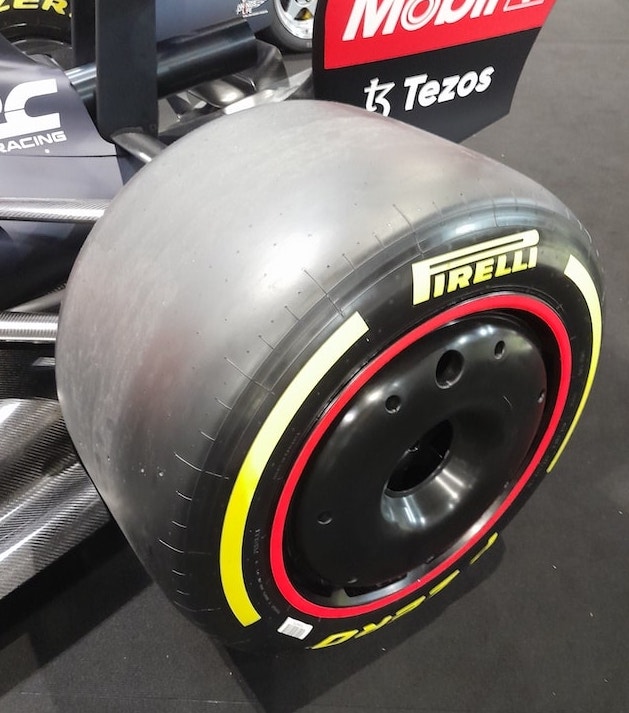
How Long Do The Hard Tires Last?
The hard tires can usually last between 25 and 60 laps during a Formula 1 race. However, this depends on the driver and the track conditions, among other factors. There have been scenarios where some drivers could have made the hard tires last the full race distance, but have been forced to stop due to the rules stating that at least two compounds must be used during dry conditions.
Key Fact: We saw Alex Albon take his hard tires to the second last lap at the 2022 Australian Grand Prix!
To understand why there is so much variation, we need to first learn how F1 tires are designed. After that, I’ll explain the differences between each compound in more detail.
Why F1 Tires Are Not Designed To Last Long
F1 tires are not designed like your average road car’s tires. Rather than being designed for durability and overall reliability on different road surfaces, F1 tires (and other racing tires) are designed for maximum performance.
For this reason, racing tires are generally not fully cured when they leave the factory (essentially this means they’re not fully hardened). If they were, they would be too hard and not offer enough grip. Because of the excessive heat generated by the high speeds and significant G-forces of F1, part of the curing process happens during the tire’s use.
F1 Tire Heat Cycles
Tires also go through heat cycles that can change the grip of the tire. In general, a tire will get harder after each heat cycle. A more evenly heated tire will go through fewer heat cycles and will have optimum grip for a longer period of time. Tire engineers understand that heat will change the composition of the rubber, so they plan for the on-track vulcanization process.
This all affects pit stop strategy, but how fast a given car’s tires will heat up and how many heat cycles they go through varies depending on a lot of different factors, not least the design of the car itself. I won’t touch on that too much here, but we do have an article about why F1 tires wear so fast that goes into more detail on it.
Are Pirelli F1 Tires Designed To Wear Faster?
What also has to be mentioned here is that the tires in Formula 1 changed a lot when Pirelli took over as sole tire supplier in 2011. In order to bring more unpredictability to the races, the FIA required Pirelli to make tires that were subject to high thermal degradation instead of normal degradation.
The latter is a normal decrease in tire performance over time (due to the thinning tread), while with thermal degradation, the tires react to heat in such a way that they can no longer withstand the loads acting on them. This results in a drop in performance of several seconds per lap.
You can learn more about this concept in our article all about tire degradation in Formula 1.
With ‘normal’ degradation, the tire can still be driven at its performance limit, although it loses performance with increasing mileage. But with thermal degradation, the tire performance will drop very quickly if it’s used to its performance limit for any length of time. This puts far more emphasis on tire management than before (see the end of this article for more on that).
Key Fact: This is why we often see drivers only able to get one good lap out of their soft tires during qualifying – they simply lose too much performance after just one lap of being on the limit.
But as I’ve pointed out above, there are some big differences between how long the tires will last depending on the compound.
Soft, Medium & Hard Tires In Formula 1
Viscoelasticity & Hysteresis
Tires are viscoelastic, and they deform under load. When the load is removed, the tire does not immediately return to its original shape, but with a delay, because part of the energy of the load is converted into heat. This delay is called hysteresis, and the basic grip of a tire is determined by its hysteresis – its ability to absorb the energy put into it.
A softer compound will tend to have a higher hysteresis (but not necessarily, as it depends on the chemical make-up). The higher the hysteresis, the more heat that will be generated.
The softness/hardness of a compound is referred to as its modulus, where:
- Low modulus = soft
- High modulus = hard
A low modulus compound will generate more ‘chemical’ grip, whereby the rubber of the contact patch chemically bonds with the surface of the track. It will also generate more ‘mechanical’ grip, whereby the unsymmetrical way the rubber is dragged over the surface, because of its hysteresis, creates a delayed reaction that tries to pull the rubber back to equilibrium.
This force is pulling in the opposite direction to that imposed by the cornering loads, and it therefore increases grip. All this basically means that softer tires tend to have more grip, which allows drivers to go faster.
Higher Grip, Lower Durability
However, the softer tires heat up quicker, wear faster, and therefore won’t last as long as the other, harder tires. The hard tires offer the least amount of grip for drivers, but they will also last the longest. whereas soft tires are usually used in qualifying to set the fastest possible lap time (the mediums may be used in parts of the Sprint Shootout).
In the race, things get more complex because there are two mechanisms that determine how soft/hard a compound actually stays. These are tire temperature and contact frequency (the frequency of the rubber’s contact with the road, mentioned above) which work in opposite directions.
Contact Frequency vs Temperature
As the temperature rises the compound becomes softer, but as the contact frequencies rise the compound becomes harder. The higher the contact frequency, the more temperature you need to generate in order to keep the tire in the ideal operating window of ‘softness.’
Key Fact: Chemical grip generally occurs between frequencies of 106-109 Hz, mechanical grip dominates between 102-106 Hz
Contact frequency refers to how the tire reacts to the load. Because rubber is a viscoelastic material, the way it reacts to loads is not consistent. Up to a certain point, the rubber accepts the incoming energy and reacts against it by springing back in the opposite direction, thereby generating grip.
But beyond this point, the rubber cannot return to its original shape fast enough to absorb the next input of load. This has the effect of stiffening and hardening the compound, and the tire begins to slide.
A Delicate Balance
This hardening can only be counteracted with higher temperatures, but every tire compound has different maximum temperatures. So, it’s a delicate balancing act to keep a tire, which as we know from earlier is also not fully cured and goes through various heat cycles, at its desired softness/hardness.
Contact frequency is determined by various things, including:
- Tire construction and suspension
- Track temperature
- Track characteristics
- Driving style
- Tire temperatures
- Aerodynamics
So, it quickly becomes clear just how difficult it can be to keep an F1 tire in its ideal operating window! Pirelli obviously understands this, and it affects which tires they bring to each race.
How Pirelli Tire Selection Works
The entire range of Formula 1 tires are C0, C1, C2, C3, C4, and C5. The C0 tire is the hardest compound that is available, whereas the C5 tire is the softest compound that is available.
Pirelli, the tire manufacturers, are the decision makers when it comes to which compounds to bring to each track depending on the track’s characteristics. However, the tire compounds will still be called soft, medium and hard and they will still have the familiar red, yellow and white branding.
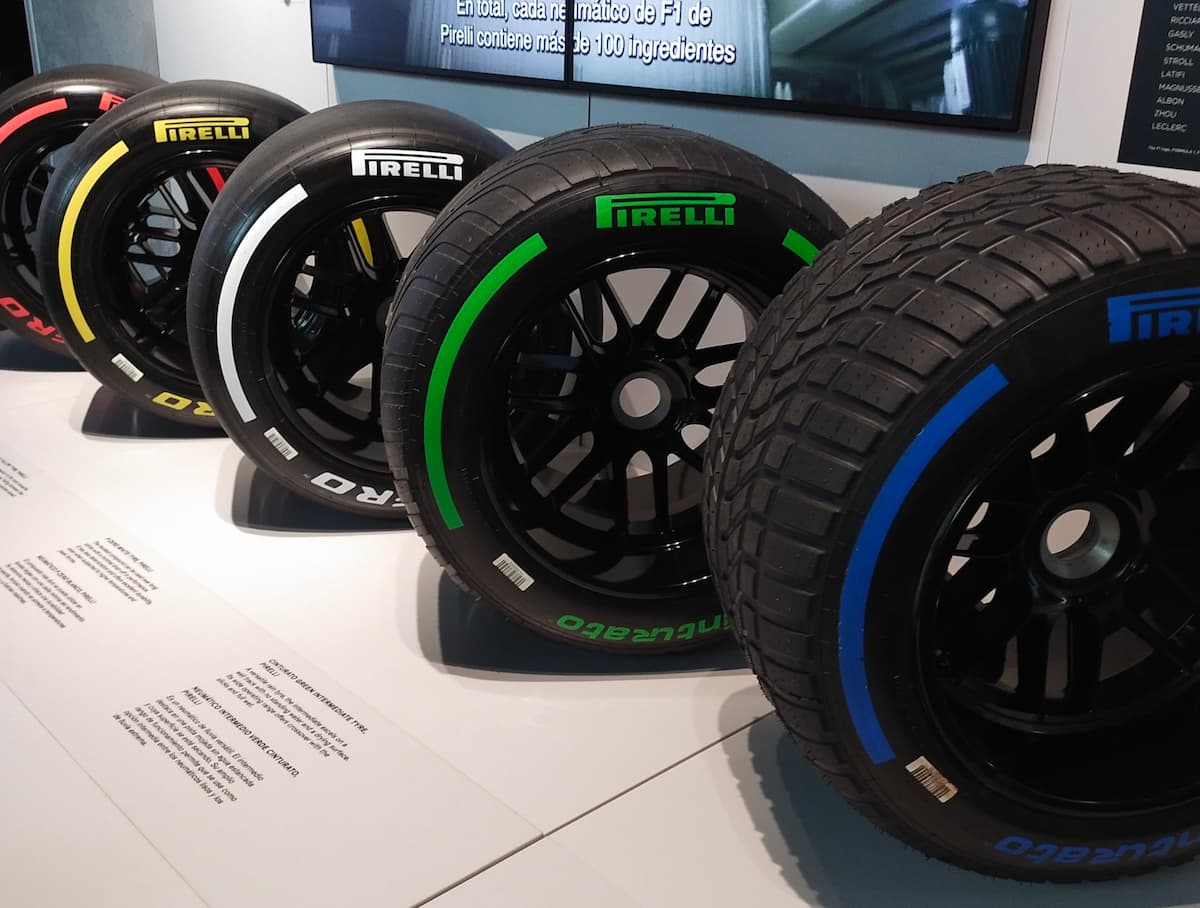
To make this easier to understand, let’s look at an example. Let’s say Formula 1 is racing in Spain, a circuit that is generally tough on tires because of the high temperatures and the many high-speed corners. Pirelli might select the C2, C3, and C4 tires for this race. The C4 tire will become the soft tire, C3 the medium tire and C2 the hard tire.
The next race on the calendar is Monaco, a tight and twisty track where cars need a lot of mechanical grip, as opposed to aerodynamic grip. The low-speed corners and generally lower top speeds means that there is much less strain on the tires, but lower downforce levels too, so the drivers need more grip from the tires to compensate for this.
Pirelli might then bring the C3, C4, and C5 tires to the Monaco Grand Prix. The C5 (not available in Spain) will become the soft tire, C4 (softest available in Spain) will be the medium tire and the C3 (medium tires in Spain) will become the hard tire.
KEY POINTS
• F1 tires last varying numbers of laps, and there are lots of factors at play
• Generally, softer tires don’t last as long as harder tires
• Pirelli takes lots of things into account when deciding which tires to bring to each track
How The Track Surface Affects How Long The Tires Last
The surface of the track also affects how long F1 tires last, as more abrasive surfaces cause tires to wear out faster. Tracks with heavy braking zones and lots of high speed corners also usually have increased tire wear, while a focus on slow speed corners and long straights usually means less wear.
The type of track has a big impact on the amount of wear an F1 tire can take. Some racetracks are especially hard on tires, in which case Pirelli would bring the harder compounds that would last longer.
One of the most important factors that influences tire wear is how abrasive the surface of the track is. This depends on the type of tarmac the track is made of, as well as how long it has been since the track has been resurfaced.
Tracks that have a more abrasive surface (rougher surface) will be harsher on the tires. These tracks tend to cause tires to wear out much quicker than they usually would. Abrasiveness can be caused by the type of asphalt that is used, or overuse of the track (if the track has not been resurfaced recently).
New vs Old Tarmac
Tracks that have recently been resurfaced might have smooth tarmac, but the new asphalt can release oils that can make the track extremely slippery. This means that the cars need more grip and would need softer tires. However, if the tires are sliding too much they will begin to overheat and wear out faster.
High-Speed Corners
Circuits with faster corners can also cause the tires to wear out faster. Circuits with a series of long fast corners will cause the tires to work harder and begin to overheat, which will wear them out much faster than usual. Usually, tracks have faster sections followed by slower sections or long straights, which does tend to help keep the tire temperatures in an ideal operating window.
Slow corners are not necessarily great for tires either, though. Whenever there are heavy braking zones there is the risk of a driver locking their brakes. If a driver locks up, they could flat spot their tires, which can render them practically useless if it’s severe enough. A flat spot on a round tire has a hugely detrimental impact on performance, and the vibrations can damage other parts of the car, never mind the fact it’s uncomfortable for the driver!
Other Factors At Play
Drivers might use a high downforce setup depending on the track layout, which can reduce wear, as downforce ‘pushes’ the car into the track, reducing the amount of sliding through the corners (which speeds up wear). Taking this to the extreme can speed up wear as a result of the increased load on the tires, and higher downforce levels can lead to higher cornering speeds and later, harder braking, which can increase wear.
But typically, higher downforce leads to reduced wear, which can make the tires last longer.
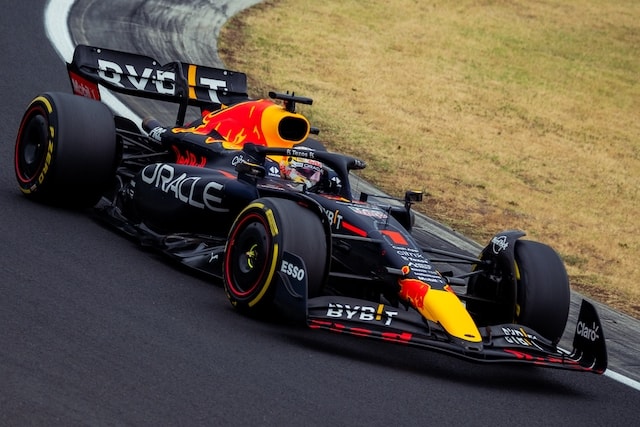
(Image Credit: Jay Hirano Photography/Shutterstock.com)
Following closely behind another car also wears the tires out faster as the driver behind has to work harder to keep the car under control in the dirty air. Dirty, turbulent air isn’t as good for generating downforce as clean air, which means the trailing car slides more in the corners, reducing grip and increasing wear, meaning the tires don’t last as long.
There are lots of other factors at play, from the suspension setup to the camber and toe of the tires. However, going into detail on all of these factors requires its own article. Luckily, we have just the post for that, so you can learn more about this in our guide about how fast F1 tires wear.
But an important factor we need to cover here is the weather.
How Do Weather Conditions Affect How Long F1 Tires Last?
Weather conditions affect how long F1 tires last in terms of temperature, wind speeds, and whether or not the track is wet. Hotter track surfaces lead to hotter tires, and while hot track surfaces offer more grip, they also bring higher chances of tires overheating.
If the weather conditions are hotter, the track temperature tends to be much higher. A high track temperature means that the tires will naturally be warmer which causes them to overheat and wear out much quicker. While drivers have more grip initially, this increased chance of overheating can make managing tires at hot tracks very tough.
In extreme cases, this can cause the carcass of the tire to heat up too much, resulting in a hot pocket of air and rubber forming inside the tire and expanding beneath the tread, ultimately bursting and breaking a chunk of the tire tread away, known as blistering.
Cold Temperatures
Colder temperatures might make the tires last longer, but it could also mean that drivers will struggle for grip. Graining is also a risk, which is when the carcass of the tire struggles to warms up and is significantly cooler than the tire surface. In order to produce grip, the tires on a Formula 1 car need to be warm enough, but not too hot, and ideally the inside of the tire and the outside tread will heat up at equal rates.
If a circuit is exceptionally windy, drivers might have to fight the wind more through the corners, and fighting against the wind affects the aerodynamics of the car to the point that it loses downforce, causing the tires to slide, wearing them out faster.
How Long Do Wet Tires Last In F1?
Wet tires can last much longer than dry tires on Formula 1 cars, even up to a full race distance (as there is no mandatory pit stop). As they’re used in wet conditions, they can stay cooler, reducing the overall rate of wear on the tires. However, wet tires can wear out within a lap or two if the track dries up.
If the track is drying, the wet and intermediate tires will begin to struggle as they overheat quickly. These tires can wear out extremely quickly if they are not kept cool. You will often see drivers purposefully hunting for and moving into puddles on a drying track in order to keep their tires cool.
Wet and intermediate tires are different to dry tires in Formula 1. The most obvious difference is that the wet and intermediate tires have treads on them whereas the dry tires are ‘slicks’ meaning they have a smooth surface.
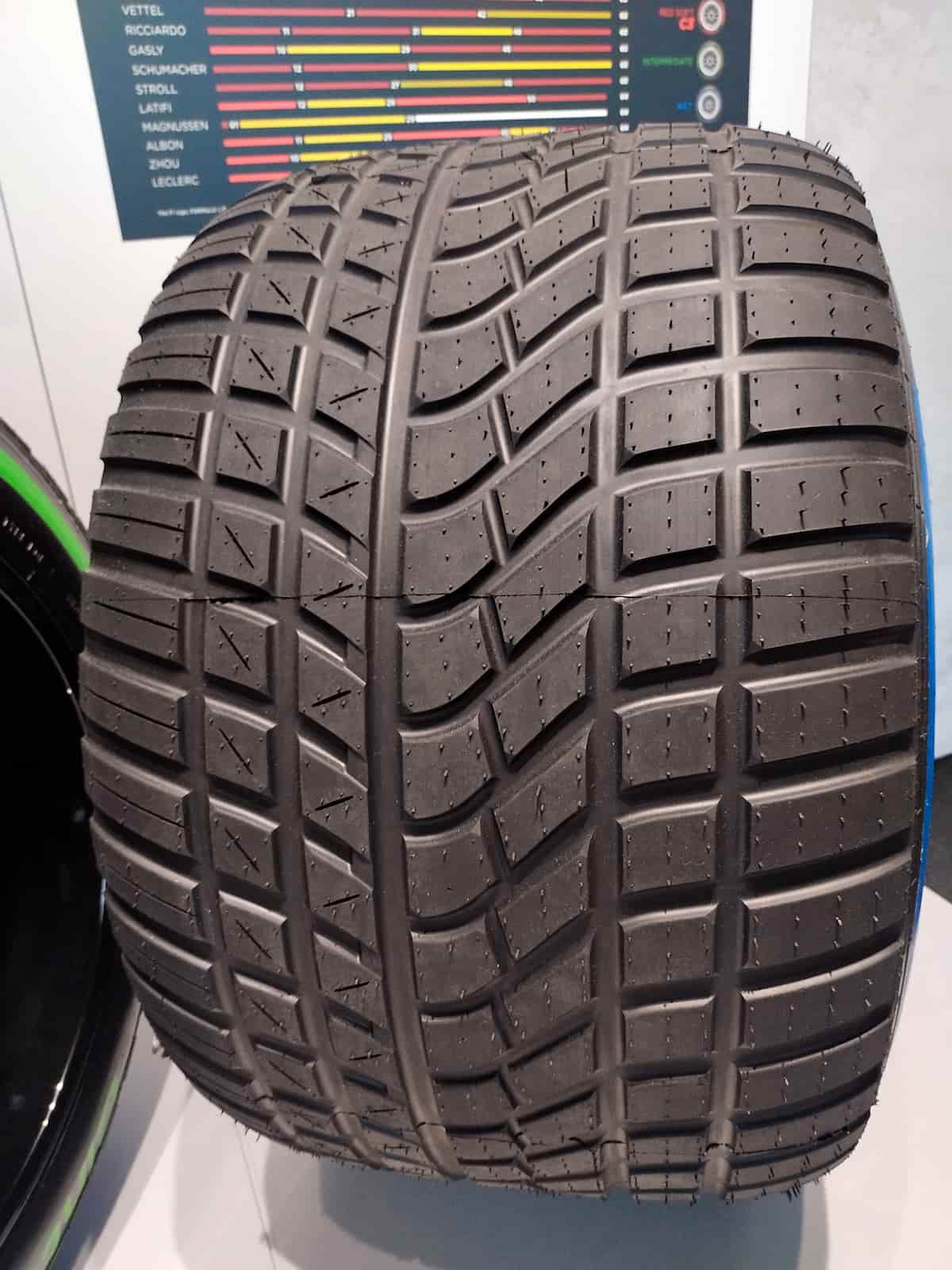

Aquaplaning
The treads that are found on wet and intermediate tires are used to disperse the water from underneath the tire. With slick tires, there is nowhere for the water to go, and therefore the wheels can be lifted up off the ground and until they are no longer making contact with the tarmac. This is known as aquaplaning, and the car will become impossible to control.
However, with the treaded tires, the ‘tread blocks’ act a bit like windshield wipers, ‘wiping’ the water from the surface of the track, through the gaps in the tread, and dispersing it away from the car. This allows the rubber on the tread blocks to remain in contact with the track.
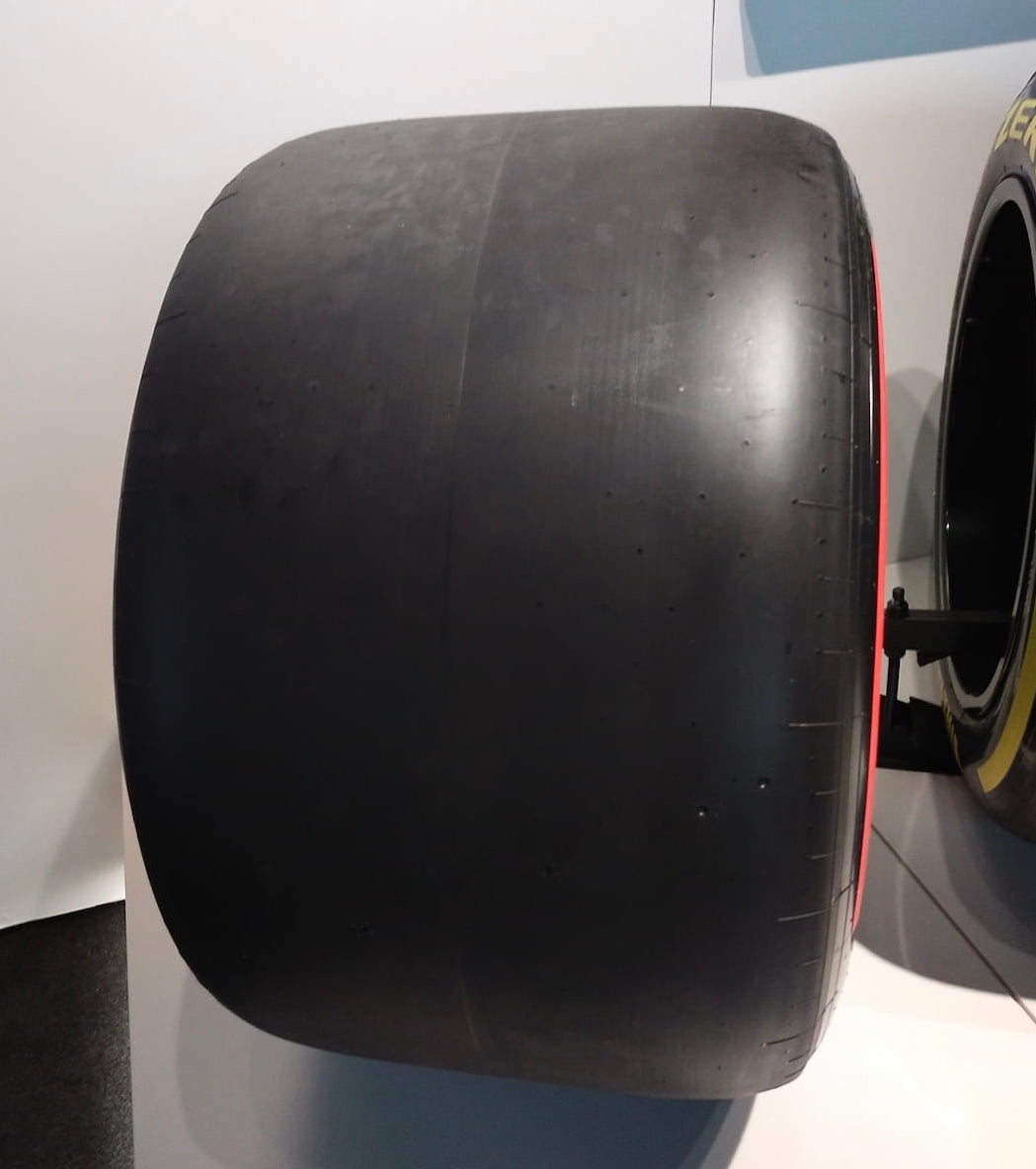
This is why the wet and intermediate tires are able to provide more grip than slick tires on a wet track. Wet tires can displace 85 liters of water per second when a formula 1 car is travelling at 190 miles per hour (300 kph).
However, this is not the only difference between wet and dry tires in Formula 1. The blocks on wet tires can also heat the tires up significantly faster than slick tires.
This is useful for Formula 1 cars because warmer tires provide more grip. However, it is only helpful as long as there is water on track to keep the tires within their ideal operating window. As soon as the track begins to dry, these blocks will cause the tires to overheat quickly. Tires that are overheating will provide the driver with no grip and they will also shred the tire much quicker.
Making Wet Tires Last The Full Race
However, if a driver can manage their wet tires, they can make them last the full race. This is because, in wet conditions, there is no mandatory pit stop. However, they’ll usually suffer in terms of performance, as they will constantly be fighting for grip as the tires are very soft, and therefore can wear relatively quickly, especially in changing conditions.
Esteban Ocon completed the Turkish GP in 2021 on a single set of intermediate tires, on a track that didn’t see much rain but remained wet enough for slicks to not be a viable option. However, given that nobody had done that since 1997, when Mika Salo went the full distance at a wet Monaco GP, it’s clearly not a common occurrence in modern F1!
KEY POINTS
• The weather plays a key role in how long F1 tires last
• Hot tracks can offer more grip, but overheating tires don’t offer much grip at all
• Wet tracks require special tires, which can last longer than dry tires but they aren’t as fast
How Can F1 Drivers Manage Their Tires?
One of the most respected attributes of some of the best Formula 1 drivers is how they manage their tires. Some drivers are able to make their tires last longer while going at the same speed as other drivers (or faster). Managing tires is all about maintaining high levels of grip without overheating the tires, and sometimes sacrificing some lap time in order to preserve the tires.
The idea is often that slower laps managing tires can balance out some of the time lost taking another pit stop. This is helpful because it allows the driver to go further into a race without stopping for new tires. The more laps they are able to do on their one set of tires, the less they will need to do on the next set, which means that they can push the next set of tires harder and go faster.
More Strategic Options
It also opens up more strategy options for the teams, as drivers will be able to make their tires last long enough for them to be able to use softer (faster) tires and still make it to the end of the race.
For example, a driver might be able to extend their tire life so far into the race that they can safely use a softer compound for their final stint. This will make them significantly faster than the cars around them during the closing stages of the race.
The main factor that affects tire wear from a driver’s point of view is how smoothly they drive. A smooth driving style will preserve the tires for longer because the tires are doing less work. Aggressive driving styles normally require the tires to work harder and provide a lot of grip at every moment, which takes a lot of their lifespan away.
Driving smoothly is a combination of proper braking, steering and throttle usage. The perfect example of a smooth driver was Jenson Button, who was able to drive fast while making his tires last as long as possible. That’s effectively the goal as an F1 driver.
How Long F1 Tires Last vs Road Car Tires
The first and most obvious difference between F1 tires and normal road tires is that Formula 1 cars use slick tires whereas road cars use treaded tires. Slick tires provide more grip because there is more rubber touching the road. Road cars need treaded tires to disperse water and avoid aquaplaning.
Another key difference is that Formula 1 tires are much larger (and specifically wider) than road car tires. This once again increases the surface area of rubber that touches the tarmac, which provides the cars with much more grip. Formula 1 cars travel at much faster speeds than road cars, especially when cornering, so the extra grip is essential.
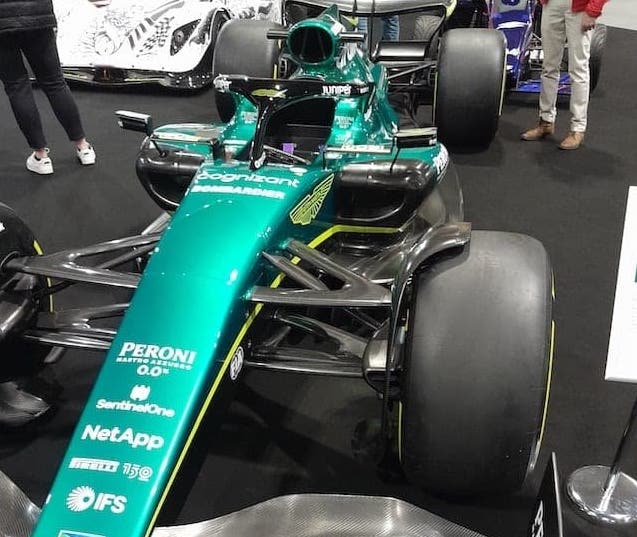
Formula 1 tires cost about $3,000 per set, which is a lot more expensive than average road car tires. In addition, Formula 1 teams use multiple sets of these tires in one race weekend. While the tires on a road car have been designed with durability in mind, Formula 1 tires have been designed with performance as the priority.
Road Car Tires Last Much Longer Than F1 Tires
Road car tires can last up to 50,000 miles, whereas most Formula 1 tires will only last a maximum of 120 miles. The full race distance that Formula 1 cars complete is 190 miles. However, this does not mean that Formula 1 tires are badly designed.
Formula 1 cars can sometimes corner at speeds of up to 190 miles per hour (300 kph), and in some cases their average speed around a lap is 150 miles per hour (240 kph). In order to cope with these extreme cornering forces, Formula 1 tires require a special kind of endurance that your average road car tires would never be able to withstand!
Final Thoughts
F1 tires usually last anywhere from a few laps to almost the full race distance. The hard compound tires are the most durable, and they can last around 120 miles (20-50 laps), depending on several conditions, such as the driver’s ability, track conditions, and the specific compound used.
I created and have been writing on this site since 2019, collaborating with drivers, coaches, engineers and manufacturers to provide you with the most reliable information about motorsport. I also make beautiful car posters and track posters.



